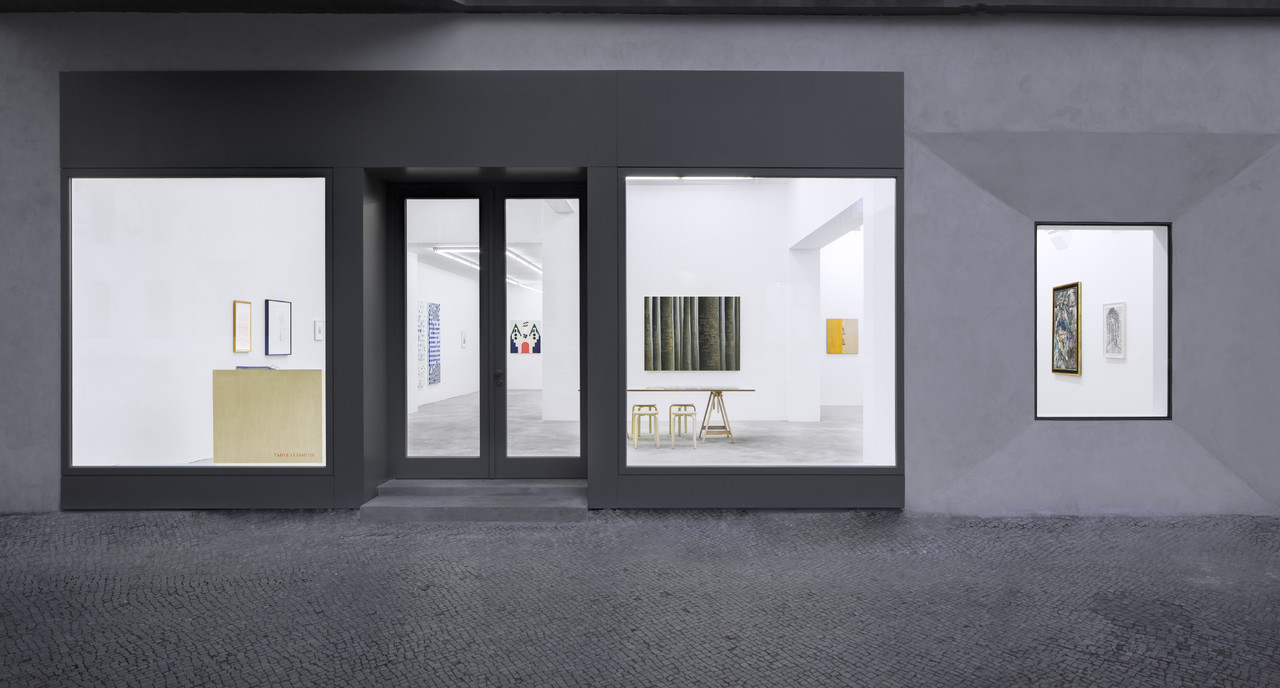For those who take epithets to heart, Math Bass’s friendly-seeming paintings at Tanya Leighton might’ve seemed laced with bitter irony. Each of Bass’s graphic gouaches is called Newz! (all works 2017): the peppy ‘z!’ making a perversely zesty backbeat over a word that, of late, has tended to presage dispiriting information. This comic attention to letters links the works to their collective title; the pictures have less to do with the disasters and misfortunes local to Fox, BBC and MSNBC than cartoon alligators, white bones doubling as speech bubbles and other animate shapes.
These entities snap life into eight mostly square and rectangular canvases, whose bare fabric serves as ground. Often, the pictures are twinned, with repeated shapes subtly modulated; I imagined these works being compare-and-contrast exercises for precocious Waldorf children, designed to model principles of general and particular. In one, a red cone sits on the canvas’s bottom edge, rounded tip meeting upper boundary; in another, the same shape has inexplicably shrunk. Next to both hangs a white speech bubble. Inside, the letter ‘Z’ suggests that the cones are snoozing. But while one ‘Z’ is wavy and calligraphic, the other is starched sans-serif, doubled to form a punchy zigzag.
With these works, Bass hits the sweet spot almost too squarely, achieving a layered palatableness that nearly erases the knots, conflicts and enigmas that make the best artworks burn slowly. Here, visual escapism blends seamlessly with historical erudition: post-painterly abstraction, sophisticated modernist design. Meanwhile, the artist's mimicking of repetitious yet shape-shifting language delivers high-minded memories of Gertrude Stein, and the more recent L=A=N=G=U=A=G=E poets. Result: the paintings are nearly impossible to dislike, unless you come to bristle at their exact orchestration, in content and form. Excepting a brushy bloom of smoke emitting from three domino-like cigarettes in one Newz painting, the works are disturbed by nary a drip or flubbed edge.
All of which brings us to the question of Bass's relationship to the mores that govern good behaviour: middle-class life on the one hand, and critically aware contemporary art on the other. While these paintings risk an allegiance with lifestyle products of ‘good taste’, they also display a healthy disregard for the dictum that good art risks failure. In recent years, the veneer of risk, as performed aesthetic vulnerability, has become such a reliable artistic strategy as to feel like a new strain of conservatism. In contrast, Bass's sometimes too-reliable procedures give unassuming expression to surprising phenomena, such as the rhythms of seeing and speaking that usually remain unremarked upon in day-to-day life.
Across Kurfürstenstrasse, in the second half of Leighton’s two-building gallery, Bass makes symbolic room for the bodies that often seem to come along for the ride, while our heads go about witnessing and decoding art. Three sculptures (all Crowd Rehearsal, 2017) are comprised of canvas constructions, brightly painted in gouache and placed on structures: a canary raincoat over a black easel, a cream pant leg over a birch ironing board, a mysterious black and white pall over a red mass, revealed by knifed slits, all atop a low cerulean platform. I couldn’t take my eyes off of these bright simulations of banal items. They have the defiant magnetism of things transitioning from useful to used up: the psychedelic leaves outside my window, the spotting banana just inside it: a romantic thought, maybe, but here a well-founded one. Far from being dismissed in Bass’s new work, language and thinking are given an echo, adequate to their weird physical facticity.
